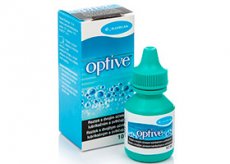Medical expert of the article
New publications
Preparations
Optive
Last reviewed: 23.04.2024

All iLive content is medically reviewed or fact checked to ensure as much factual accuracy as possible.
We have strict sourcing guidelines and only link to reputable media sites, academic research institutions and, whenever possible, medically peer reviewed studies. Note that the numbers in parentheses ([1], [2], etc.) are clickable links to these studies.
If you feel that any of our content is inaccurate, out-of-date, or otherwise questionable, please select it and press Ctrl + Enter.

Optiva contains elements such as carmellose Na and glycerol, which have a protective effect on the epithelial layer of the cornea.
The drug substance increases the stability of the tear film function, and at the same time leads to an improvement in the processes of hydration of the eye cornea during various conditions and diseases, in which there is a decrease in the volume of lacrimal fluid produced.
 [1]
[1]
Indications Optive
It is used to eliminate the negative manifestations arising in connection with the development of dry keratoconjunctivitis.
 [2],
[2],
Pharmacodynamics
Na carmellose has no therapeutic properties that have an effect through nerve endings. The drug acts physically - it has a moisturizing effect and increases the stability of the eyes.
The component increases the lacrimal viscosity, and with it has a pseudo-elastic effect. Because carmellose Na is considered to be a polymer of ions and includes hydroxyl from the carboxyl category, the chemical structure of the element is similar to mucin inside the tear film; thanks to this substance demonstrates mucoadhesive activity. All this stimulates the extension of the stable work of the eye and reduces the symptoms observed with a lack of tear fluid.
Dosing and administration
Instill drops Optive required inside the conjunctival sac, in portions of 1-2 drops.
Use Optive during pregnancy
Adequate testing of the drug with the participation of lactating or pregnant women was not performed. In tests involving animals, no noticeable negative manifestations and effects on the course of pregnancy and the state of the mother and fetus were found.
The operative element of Optiva is not absorbed from the mucous membranes, therefore it cannot be eliminated during lactation.
Contraindications
It is contraindicated to prescribe in case of strong intolerance regarding the drug.

Side effects Optive
Among the adverse events:
- dry ocular mucosa;
- development of redness or redness of the conjunctiva;
- feeling of irritation in the eyes or the appearance of "fog";
- eye itching;
- the appearance of crusts on the edges of the eyelids;
- discomfort when performing instillation of the drug.
Post-marketing tests revealed the development of such negative symptoms in patients using the medication:
- puffiness in the eyelid area;
- pain in the eyes;
- photosensitivity;
- feeling of a foreign object in the eye area;
- increase the intensity of tearing.

Interactions with other drugs
To prevent the medication from leaching it is necessary to observe a minimum 5-minute break between using Optive and other ophthalmic drugs for local treatment.
 [7]
[7]
Storage conditions
The optiva should be kept at temperature values not exceeding 25 ° C.

Shelf life
The optive is allowed to be used for a 24-month period from the time the therapeutic agent is manufactured.
 [8]
[8]
Attention!
To simplify the perception of information, this instruction for use of the drug "Optive" translated and presented in a special form on the basis of the official instructions for medical use of the drug. Before use read the annotation that came directly to medicines.
Description provided for informational purposes and is not a guide to self-healing. The need for this drug, the purpose of the treatment regimen, methods and dose of the drug is determined solely by the attending physician. Self-medication is dangerous for your health.

